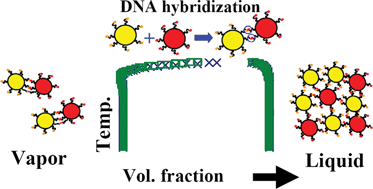Anomalous phase behavior of liquid–vapor phase transition in binary mixtures of DNA-coated particles
Abstract
We report a Monte Carlo study of a 1 : 1 binary mixture of particles coated with

* Corresponding authors
a
Department of Chemistry, University of Cambridge, Lensfield Road, Cambridge, UK
E-mail:
fjm45@cam.ac.uk
b Department of Chemistry, Columbia University, 3000 Broadway, New York, NY, USA
We report a Monte Carlo study of a 1 : 1 binary mixture of particles coated with

 Please wait while we load your content...
Something went wrong. Try again?
Please wait while we load your content...
Something went wrong. Try again?
F. J. Martinez-Veracoechea, B. Bozorgui and D. Frenkel, Soft Matter, 2010, 6, 6136 DOI: 10.1039/C0SM00567C
To request permission to reproduce material from this article, please go to the Copyright Clearance Center request page.
If you are an author contributing to an RSC publication, you do not need to request permission provided correct acknowledgement is given.
If you are the author of this article, you do not need to request permission to reproduce figures and diagrams provided correct acknowledgement is given. If you want to reproduce the whole article in a third-party publication (excluding your thesis/dissertation for which permission is not required) please go to the Copyright Clearance Center request page.
Read more about how to correctly acknowledge RSC content.
 Fetching data from CrossRef.
Fetching data from CrossRef.
This may take some time to load.
Loading related content
